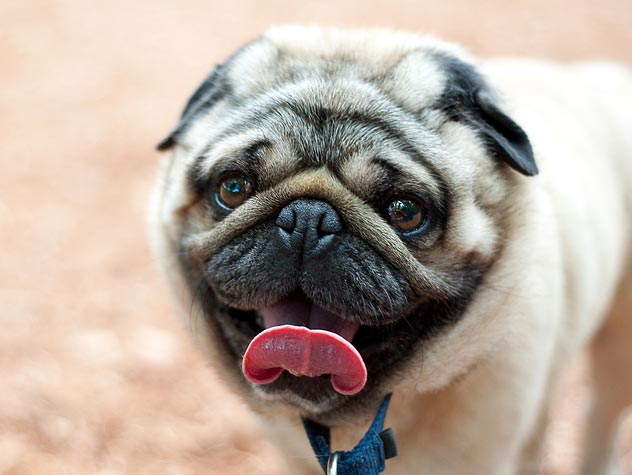Chinese Shar-Pei
The Chinese Shar-Pei is an ancient breed that stands out from the crowd with its unique appearance that features loose folds of skin, scowling expressions, a hippopotamus muzzle, and “sandpaper” coats (literally translated from “Shar-Pei”). Their short, bristly coats come in a variety of colors, further adding to their distinctive look. Despite their imposing stature, Shar-Pei are known for their intelligence and serenity, though their independence and suspicion of outsiders necessitate early training.
Breed characteristics carousel
Learn More
Need to Know
- Suitable for experienced owners
- Extra training required
- Potential health issues
- Enjoys vigorous walks
- Medium dog
- Some drool
- Requires regular grooming
- Chatty and vocal dog
- Barks, alerts, and may be physically protective/suspicious of visitors
- Might not like other dogs
- May need additional training to live with other pets
- May need additional supervision to live with children
- Needs a large yard
- Can live in suburban or rural areas
- Can be left alone occasionally with training
- AKC Registered Breed

Personality
The Chinese Shar-Pei’s personality is a complex blend of loyalty and independence. Well-socialized pups are devoted to their families and playful at times but often possess an aloof demeanor. Their stubborn streak can emerge without proper training, manifesting as territorial behavior. Shar-Pei are naturally wary of strangers, requiring careful introductions. Other pets can be a coin toss; they may integrate well with cats raised alongside them, but other dogs might be met with suspicion or even aggression.
Native to China’s southern provinces, the Shar-Pei goes back more than 2,000 years to the Han Dynasty. These loyal companions were believed to be descended from the ancient Han Dog, sharing the tell-tale blue tongue with their larger cousin, the Chow Chow. Prized by peasants for their versatility, Shar-Pei served as hunters, herders, and livestock protectors. Their intelligence and ruggedness made them invaluable companions. China’s political climate, however, proved challenging for the Shar-Pei. Although the establishment of the Communist regime in 1949 saw a steep decline in dog ownership, thankfully, a few Shar-Pei survived in Hong Kong and Taiwan, carrying the torch for this unique breed. American interest in the breed began in 1973. That same year, a Hong Kong breeder named Matgo Law appealed to the U.S. to save the endangered Shar-Pei from extinction. Today, they are one of the most recognizable breeds in America.
The ideal owner for a Chinese Shar-Pei is someone who appreciates their unique appearance and enjoys a certain level of independence in their canine companion. These independent thinkers may view training as beneath them, requiring an owner who can approach training with patience and consistency.
The Chinese Shar-Pei is an adaptable companion when it comes to exercise, as long as their mental and physical stimulation needs are met. Depending on their owner’s activity level, they’re just as content with long walks as they are short ones. Adult Shar-Pei typically require at least an hour of exercise daily, but they’re happy to receive more. This can include walks, playtime in a fenced yard, or even participation in dog sports like obedience or agility, especially for the more energetic Shar-Peis. However, due to their caution of other dogs, leash walks in areas with moderate canine traffic might be ideal to avoid altercations.
A cozy home with a decent yard creates the perfect environment for this independent pup. They prefer environments away from other dogs, with room to relax and enjoy the outdoors without feeling overwhelmed.
The Shar-Pei’s intelligence can be both a blessing and a curse when it comes to training. While they are quick learners, their independent spirit and stubborn streak can make them a challenge, especially for first-time dog owners. Even if basic obedience might seem beneath their dignity, mastering commands like walking on a leash and wearing a harness is essential for a well-behaved Shar-Pei.
The Shar-Pei’s intelligence can be both a blessing and a curse when it comes to training. While they are quick learners, their independent spirit and stubborn streak can make them a challenge, especially for first-time dog owners. Even if basic obedience might seem beneath their dignity, mastering commands like walking on a leash and wearing a harness is essential for a well-behaved Shar-Pei.
While Shar Pei can be loyal companions, their preference for calm, quiet environments might not suit active families with young children. You may want to consider a different breed if your household is full of rambunctious energy.
The cost of a Chinese Shar-Pei from a breeder is significantly more than the cost of adopting one from a local shelter or rescue. The adoption fee usually covers additional items such as spaying or neutering, vaccines, and microchipping.

Learn more about feeding and caring for your Chinese Shar-Pei on Purina.
Did You Know?
- The name “Shar-Pei” translates to “sand skin,” referencing their short coat’s unique, gritty texture. Petting them the wrong way can feel quite scratchy!
- The Shar-Pei’s blue-black tongue is a fascinating reminder of their shared ancestry with their close cousin, the Chow Chow.


